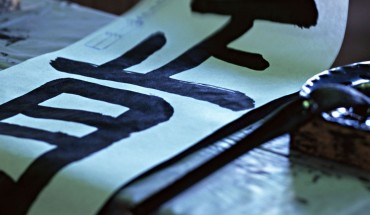Here comes another very beautiful story from the ancient days of early Buddhism. Enjoy:
At that time in the Mahāvihāra lived a monk named Tissabhūti who was currently studying the books of monastic discipline. One early morning while he was on his almsround through the village he happened to see a rather poisonous sight and thoughts of lust crept into his mind. Immediately, stopping on the spot, he thought: “Now, if this thought is going to grow it will drag me into hell”. Thus in that very spot he turned to a novice monk and poured the gruel which he had received into the bowl of the younger monk. He then went back to the monastery to his teacher, bowed down, and said: “In me a disease arose. If i can cure it i will come back, if not, i will not come back again.”
Then he went to the venerable elder Mahāsaṅgharakkhita, a renowned meditation master, who lived in Malaya. This elder was plastering the flooring of his small leaf hut, and, without even looking up, said to the venerable Tissabhūti:
“Brother, lay down your bowl and robe.” –
“Sir, a disease appeared in me. Only if you can help me cure it, i will lay down my robe and my bowl.” –
“Brother, you have come to one who is capable of healing diseases, lay down robe and bowl.”
Obediently thinking that “this teacher would not say what he does not know” he put down his robe and bowl, showed respect to the elder and sat down to one side.
Mahāsaṅgharakkhita knowing: ‘ this fellow is of a greedy character’ explained to him the meditation subject on the loathsomeness of the body in great detail. Then venerable Tissabhuti got up, put the upper robe and his bowl over his shoulder and repeatedly worshiped the elder monk with much enthusiasm. Seeing this, venerable Mahāsaṅgharakkhita asked him, why he made such an affectionate departure.
“Dear Sir, if i should be able to succeed in realizing my duty, then that’s fine. If i will not be able to, this will be the last time i see you.”
“Go now, brother Tissabhuti! For such earnest and devoted young men like yourself it is not difficult to attain jhanas or vipassana or the path and the fruit of nibbana.”
Then the venerable Tissabhuti again showed great respect to his teacher and left going back to his monastery. He stopped and sat down under a sepanni tree which he had seen earlier on his way. There, hidden under the root of the tree he developed his meditation object on the loathesomeness of the body and based on it developed insight and realized the fruit of Arahantship (nibbana).
He just arrived in time for the evening recitation.
—
For those of you who like to read the pali version (AN Commentary, PTS page 1.39):
Aparopi tasmiṃyeva mahāvihāre tissabhūtitthero nāma vinayaṃ gaṇhanto bhikkhācāravelāyaṃ antogāmaṃ paviṭṭho visabhāgārammaṇaṃ olokesi. Tassa lobho uppajji, so patiṭṭhitapādaṃ acāletvā attano patte yāguṃ upaṭṭhākadaharassa patte ākiritvā ‘‘ayaṃ vitakko vaḍḍhamāno maṃ catūsu apāyesu saṃsīdāpessatī’’ti tatova nivattitvā ācariyassa santikaṃ gantvā vanditvā ekamantaṃ ṭhito āha – ‘‘eko me byādhi uppanno, ahaṃ etaṃ tikicchituṃ sakkonto āgamissāmi, itarathā nāgamissāmi. Tumhe divā uddesañca sāyaṃ uddesañca maṃ oloketvā ṭhapetha, paccūsakāle uddesaṃ pana mā ṭhapayitthā’’ti evaṃ vatvā malayavāsimahāsaṅgharakkhitattherassa santikaṃ agamāsi. Thero attano paṇṇasālāya paribhaṇḍaṃ karonto taṃ anoloketvāva ‘‘paṭisāmehi, āvuso, tava pattacīvara’’nti āha. Bhante, eko me byādhi atthi, sace tumhe taṃ tikicchituṃ sakkotha, paṭisāmessāmīti. Āvuso, uppannaṃ rogaṃ tikicchituṃ samatthassa santikaṃ āgatosi, paṭisāmehīti. Subbaco bhikkhu ‘‘amhākaṃ ācariyo ajānitvā evaṃ na vakkhatī’’ti pattacīvaraṃ ṭhapetvā therassa vattaṃ dassetvā vanditvā ekamantaṃ nisīdi.
Thero ‘‘rāgacarito aya’’nti ñatvā asubhakammaṭṭhānaṃ kathesi. So uṭṭhāya pattacīvaraṃ aṃse laggetvā theraṃ punappunaṃ vandi. Kiṃ, āvuso, mahābhūti atirekanipaccakāraṃ dassesīti? Bhante, sace attano kiccaṃ kātuṃ sakkhissāmi, iccetaṃ kusalaṃ. No ce, idaṃ me pacchimadassananti! Gacchāvuso, mahābhūti tādisassa yuttayogassa kulaputtassa na jhānaṃ vā vipassanā vā maggo vā phalaṃ vā dullabhanti. So therassa kathaṃ sutvā nipaccakāraṃ dassetvā āgamanakāle vavatthāpitaṃ channaṃ sepaṇṇigacchamūlaṃ gantvā pallaṅkena nisinno asubhakammaṭṭhānaṃ pādakaṃ katvā vipassanaṃ paṭṭhapetvā arahatte patiṭṭhāya paccūsakāle uddesaṃ sampāpuṇi. Evarūpānaṃ ganthavasena vikkhambhitā kilesā tathā vikkhambhitāva honti.
Our thanks go to Ven. Buddhaghosa for preserving these stories 🙂



